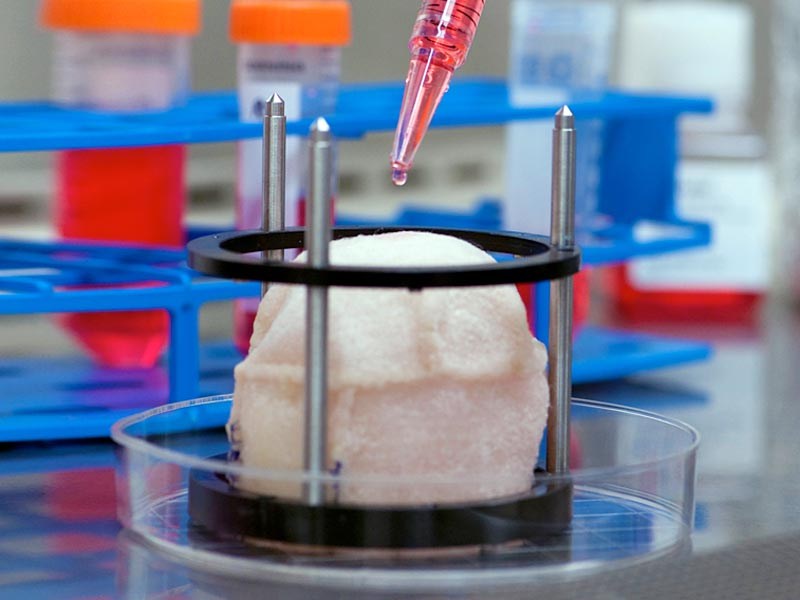Based on
the lectures, there seems to be a large amount of controversy associated with bioart. In particular, genetic engineering poses a huge dilemma on whether
tampering with life’s code is being taken too far.
When
looking at an artist such as Eduardo Kac, there is some legitimacy to the
claims that his fluorescent bunny does not serve much purpose. Although he tries
to validate his art by saying how it creates a dialogue between professionals
and the public on genetic engineering[1], the work still borders on
being unethical since he did it just for the sake of art without much
consideration for the bunny’s well-being. Moreover, the idea was
not anything new since Japanese researchers did the same process for lab rats
several years earlier[1]. If anything, this work makes it seem
acceptable for the public to use transgenic art on other pets and animals.

Kac is
not the only offender of using genetic engineering to create controversy. Many
big corporations are putting genetically modified organisms in their crops,
which are starting to show its negative effects in recent years. In fact,
studies show that there are already 18 million Americans who suffer from gluten
insensitivity due to wheat hybridization and GMOs[2]. When greed and
selfishness enter into biology, the outcomes can be harmful to many people. The
well-being of others is not worth the cost of a genetically modified piece of
corn.
Conversely,
there are those who are actually making a positive impact through bioart and bioengineering.
Artist Kathy High took retired lab breeder rats in an effort to make them feel
healthy again by playing with them, feeding them, and cleaning them[3][4].
Her use of empathy for the rats makes her art seem much more altruistic
compared to that of Kac. This is the type of bioart that many artists should
aspire to: one that can be beneficial to someone or something.



Furthermore,
a positive display of bioengineering comes from Anthony Atala’s group that
grows human organs by using cells in the person’s body[5]. These
intricate structures are almost like art pieces because they are carefully
designed and crafted with technology. On the other hand, their work is also
helping and saving lives in the process. Overall, this group is using the power of
bioengineering to do some actual good in the world. The only controversial part about their studies is that there are not
enough of them around.

In order
to end controversy, one simple remedy might be to use bioart and
bioengineering in a way that can be helpful to either humans or nature. This is
the reason why the latter examples of High and Atala are surrounded with little
to no controversy. They are the artists and scientists who understand that life
in art and science must be done with a lot of care and consideration.
Sources:
1. Vesna, Victoria. "Biotechnology Part 1." YouTube. uconlineprogram,
18 Sept. 2013. Web. 13 July 2016. <https://www.youtube.com/watch?v=PaThVnA1kyg>.
2. Sarich, Cristina. "18 Million Americans Suffer from GMO
and Gluten Intolerance." Natural
Society. Natural Society, 8 July 2014. Web. 13 July 2016. <http://naturalsociety.com/18-million-americans-suffer-gmo-gluten-intolerance/>.
3. High, Kathy. "Rat Care Manual." Embracing Animal. N.d. Web.
13 July 2016. <http://www.embracinganimal.com/ratcare.html>.
4. Vesna, Victoria. "Biotechnology Part 3." YouTube. uconlineprogram, 17 May. 2012. Web. 13 July 2016. <https://www.youtube.com/watch?v=3EpD3np1S2g>.
5. Atala, Anthony. "Anthony Atala: Growing New
Organs." TEDMED. TED. TEDMED, Oct. 2009. Web. 13 July 2016. <https://www.ted.com/talks/anthony_atala_growing_organs_engineering_tissue#t-6010>.
6. Pollan, Michael. "POV | Food, Inc. | Interview with
Michael Pollan | PBS." Interview. YouTube. PBS, 16 Apr. 2010. Web. 13 July
2016. <https://www.youtube.com/watch?v=0Ty0eehT8Y4>.
Images:
1. Alba. N.d. Potopov. By Potopov. 5 Nov. 2015. Web. 13 July
2016. <http://potopov.com/blog/index.php?tag/references>.
2. "Best to Avoid GMO's and Go Organic..." Pinterest.
Pinterest, n.d. Web. 13 July 2016. <https://www.pinterest.com/peace4meman/hell-no-gmos-and-all-that-other-nastiness/>.
3. Embracing Animal. N.d. Kathy High. By Kathy High. Web. 13
July 2016. <http://kathyhigh.com/project-embracing-animal.html>.
4. Anthony Atala: Growing New Organs. N.d. TED. By Anthony
Atala. TEDMED, Oct. 2009. Web. 13 July 2016. <https://www.ted.com/talks/anthony_atala_growing_organs_engineering_tissue#t-6010>.

I think you bring up a good point that bioart and bioengineering should be used to help (not hinder) humans and nature. However, I think along with that comes multiple questions at play: from a utilitarian point of view, what constitutes the greater good? It also makes me question, what are the tradeoffs among some of the pieces we covered? And finally, which is a bit of an extension to the first question, is a social critique considered as valuable as bioengineering if it means helping humans in general? I think your post definitely brings up a good discussion!
ReplyDelete